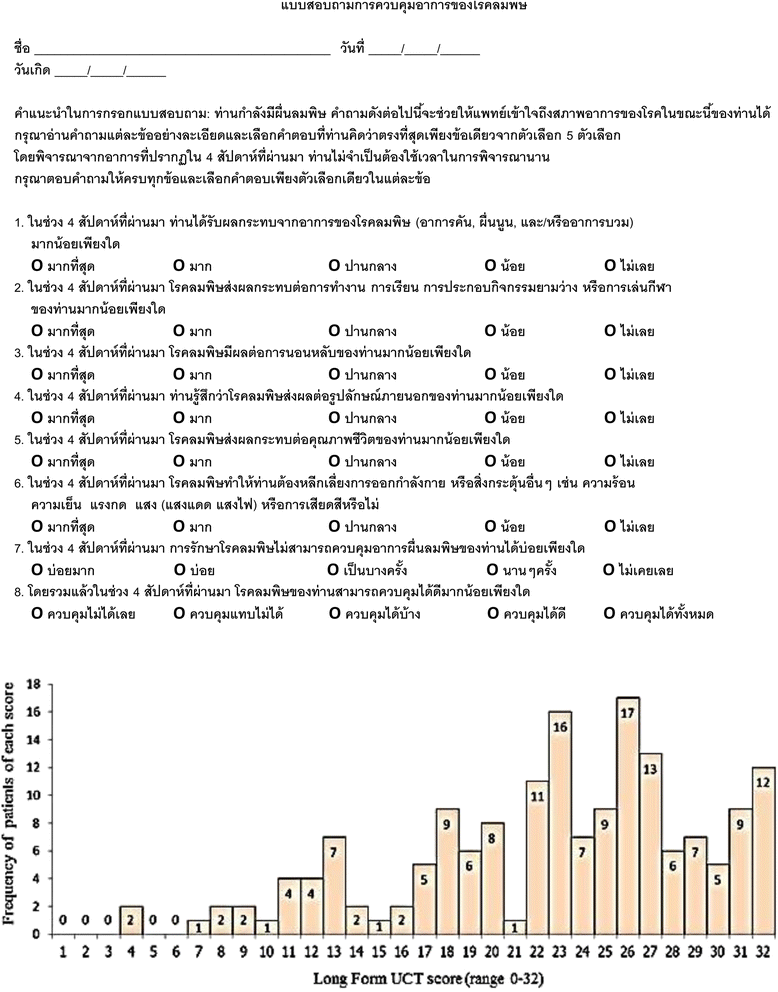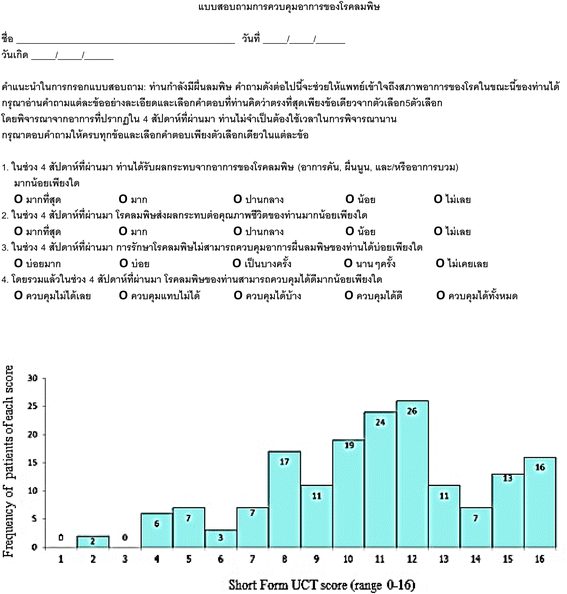Validity, reliability and interpretability of the Thai version of the urticaria control test (UCT)
- PMID: 27075142
- PMCID: PMC4831163
- DOI: 10.1186/s12955-016-0466-y
Validity, reliability and interpretability of the Thai version of the urticaria control test (UCT)
Abstract
Background: The Long Form and Short Form of the German (original) version of the Urticaria Control Test (UCT) have shown to be valid and reliable instruments for assessing patients with all types of chronic urticaria (CU). The cutoff scores for identifying patients with well-controlled disease were ≥ 24 and ≥ 12 for Long and Short Forms, respectively. However, the sensitivity to change and minimal clinically important difference (MCID) of the UCT have never been systematically evaluated. This study aimed to investigate the validity, reliability, screening accuracy, sensitivity to change and MCID of the linguistically validated translation of the UCT into the Thai language for assessing CU in the Thai population.
Methods: A structured translation and pre-testing were done to cross-culturally adapt the UCT for the Thai language. All measurement properties of both forms of the Thai UCT were validated in 169 patients with CU.
Results: There were strong correlations between the Thai UCT score and disease activity, health-related quality of life impairment, and disease control (all correlations ≥ 0.7). Good internal consistency and excellent intra-rater reliability were demonstrated. The same cutoff scores to define patients with well-controlled disease should be used as those recommended for the original UCT version. MCIDs equated to increase in scores of 6 and 3 for the Long and Short Forms, respectively, of the Thai UCT should be used to identify patients who had minimal responses. Score increments of ≥ 10 and ≥ 6 for Long and Short Forms, respectively, should be used to define patients who had marked responses.
Conclusions: This study confirmed the applicability of the UCT for use in Thailand, a country that has a very different language and cultural setting than that of Germany and the United States. Further studies are required to examine the suitability of the UCT for use in the pediatric population.
Keywords: Chronic urticaria; Minimal clinically important difference (MCID); Reliability; Urticaria Control Test (UCT); Validity.
Figures
Similar articles
-
Minimal clinical important difference (MCID) of the Thai Chronic Urticaria Quality of Life Questionnaire (CU-Q2oL).Asian Pac J Allergy Immunol. 2016 Jun;34(2):137-45. doi: 10.12932/AP0674.34.2.2016. Asian Pac J Allergy Immunol. 2016. PMID: 27007835
-
Validation of the Turkish version of the Urticaria Control Test: Correlation with other tools and comparison between spontaneous and inducible chronic urticaria.World Allergy Organ J. 2019 Jan 26;12(1):100009. doi: 10.1016/j.waojou.2018.11.007. eCollection 2019. World Allergy Organ J. 2019. PMID: 30937134 Free PMC article.
-
Evaluation of the Reliability and Validity of the Persian Version of Urticaria Control Test (UCT).Iran J Allergy Asthma Immunol. 2021 Aug 7;20(4):423-431. Iran J Allergy Asthma Immunol. 2021. PMID: 34418896
-
Validity, reliability, and interpretability of the Brazilian urticaria control test.Allergy Asthma Proc. 2020 May 1;41(3):e61-e66. doi: 10.2500/aap.2020.41.200003. Allergy Asthma Proc. 2020. PMID: 32375971
-
Quality of life measurement in assessing treatment effectiveness in urticaria: European experts position statement.Int J Dermatol. 2024 Dec;63(12):1657-1667. doi: 10.1111/ijd.17366. Epub 2024 Jul 4. Int J Dermatol. 2024. PMID: 38965063 Review.
Cited by
-
Urticaria from the Neurodermatological Perspective: A Temporal Analysis of Urticaria and Cognition.Adv Exp Med Biol. 2021;1339:209-220. doi: 10.1007/978-3-030-78787-5_26. Adv Exp Med Biol. 2021. PMID: 35023108
-
Chronic spontaneous urticaria activity, impact and control as well as their changes are strongly linked, and these links are not affected by angioedema or comorbid inducible urticaria - Results from the validation of the Polish Urticaria Control Test.World Allergy Organ J. 2022 Mar 21;15(3):100635. doi: 10.1016/j.waojou.2022.100635. eCollection 2022 Mar. World Allergy Organ J. 2022. PMID: 35399816 Free PMC article.
-
Adaptation and Validation of the Korean Version of the Urticaria Control Test and Its Correlation With Salivary Cortisone.Allergy Asthma Immunol Res. 2019 Jan;11(1):55-67. doi: 10.4168/aair.2019.11.1.55. Allergy Asthma Immunol Res. 2019. PMID: 30479077 Free PMC article.
-
Validity, reliability, and sensitivity to change of the traditional Chinese Urticaria Control Test (UCT) in Hong Kong.J Allergy Clin Immunol Glob. 2024 Jun 12;3(3):100290. doi: 10.1016/j.jacig.2024.100290. eCollection 2024 Aug. J Allergy Clin Immunol Glob. 2024. PMID: 39040655 Free PMC article.
-
Disease Severity, Activity, Impact, and Control and How to Assess Them in Patients with Hereditary Angioedema.Front Med (Lausanne). 2017 Dec 4;4:212. doi: 10.3389/fmed.2017.00212. eCollection 2017. Front Med (Lausanne). 2017. PMID: 29255709 Free PMC article. Review.
References
-
- Jáuregui I, De Frutos FJ O, Ferrer M, Giménez-Arnau A, Sastre J, Bartra J, et al. Assessment of Severity and Quality of Life in Chronic Urticaria. J Investig Allergol Clin Immunol. 2014;24:80–86. - PubMed
MeSH terms
LinkOut - more resources
Full Text Sources
Other Literature Sources
Medical



